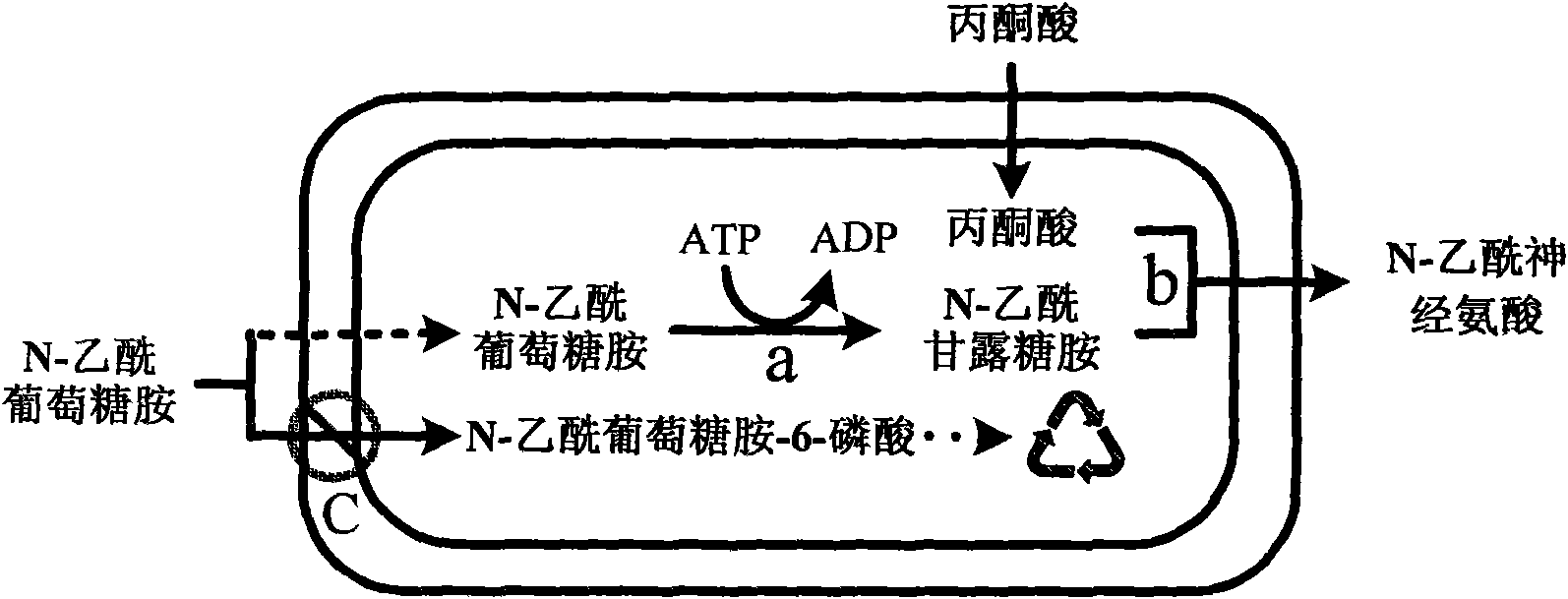Recombinant escherichia coli of temperature-control coexpression exogenous gene and application thereof
A technology for recombining Escherichia coli and exogenous genes, applied in the direction of microorganism-based methods, bacteria, microorganisms, etc., can solve the problems of toxic substances, low conversion rate of whole cells, recombinant catalysts that are not suitable for large-scale preparation, etc.
- Summary
- Abstract
- Description
- Claims
- Application Information
AI Technical Summary
Problems solved by technology
Method used
Image
Examples
Embodiment 1
[0075] Example 1: Construction of recombinant genetic engineering strain Escherichia coli (Escherichia coli) DT26 (pBVNsS) CCTCC NO: M 209018
[0076] 1. Cloning of N-acetylneuraminic acid aldolase gene (nanA)
[0077] The genomic DNA of bacterial strain Escherichia coli K12 ATCC 25404 was prepared by a conventional method, and this process can be referred to the method for small-scale preparation of bacterial genome in "Guide to Molecular Biology" published by Science Press; using synthetic primers from Escherichia coli K12 The N-acetylneuraminidase gene nanA was obtained by PCR amplification from the genomic DNA. The fragment was recovered after double digestion with EcoRI and PstI, and connected to the recovered plasmid pBV220 treated with the same enzymes (see Acta Virus Sinica, Vol. 6, No. 2, pp. 111-116).
[0078] Among them, the above-mentioned Escherichia coli K12ATCC 25404 is used as the source bacterium of the nanA gene, and according to the genome sequence of the b...
Embodiment 2
[0116] Example 2: Application of Whole Cell Catalysts in the Synthesis of N-Acetylneuraminic Acid
[0117](1) Plate culture: Streak the above-mentioned Escherichia coli (Escherichia coli) DT26 (pBVNsS) CCTCC NO: M 209018 strain on an ampicillin LB plate containing 1.5% agar with a mass volume ratio of 100 μg / ml, and culture at 37°C 12 hours.
[0118] (2) First-class seeds: under aseptic conditions, pick a single colony on the flat plate of step (1) with a sterile toothpick, then inoculate into 5 ml of liquid medium containing 100 μg / ml ampicillin, 30 Cultivate on a shaker for 12 hours.
[0119] (3) Shake flask culture: under aseptic conditions, take the culture solution cultivated in step (2) as an inoculum size of 1% by volume, and inoculate it into 30 ml of LB liquid medium containing 100 μg / ml of ampicillin, Incubate on a rotary shaker at 30°C at 200 rpm for 2 hours.
[0120] (4) Induction: the shaker flask was moved to a shaker at 45° C., and induced at 180 rpm for 4 ho...
Embodiment 3
[0131] Example 3: Application of Whole-Cell Catalysts in the Synthesis of N-acetylneuraminic Acid
[0132] (1) Plate culture: Streak the Escherichia coli (Escherichia coli) DT26 (pBVNsS) CCTCC NO: M 209018 strain on an ampicillin LB plate containing 1.5% agar with a mass volume ratio of 100 μg / mL, culture at 37°C for 12 Hour.
[0133] (2) First-class seeds: under aseptic conditions, pick a single colony on the plate of step (1) with a sterile toothpick, and then inoculate it into 5 ml of liquid medium containing 100 μg / ml ampicillin, 37 Cultivate on a shaker for 12 hours.
[0134] (3) Secondary seed: under aseptic conditions, get the nutrient solution cultivated in step (2) with a volume ratio of 1% inoculum, inoculate to 500ml LB inorganic salt liquid medium containing ampicillin of 100 μg / ml Incubate at 30°C for 12 hours with shaking.
[0135] (4) Fermentation tank culture: under sterile conditions, take the culture solution obtained in step (3) and inoculate 5 L of the a...
PUM
 Login to View More
Login to View More Abstract
Description
Claims
Application Information
 Login to View More
Login to View More - R&D
- Intellectual Property
- Life Sciences
- Materials
- Tech Scout
- Unparalleled Data Quality
- Higher Quality Content
- 60% Fewer Hallucinations
Browse by: Latest US Patents, China's latest patents, Technical Efficacy Thesaurus, Application Domain, Technology Topic, Popular Technical Reports.
© 2025 PatSnap. All rights reserved.Legal|Privacy policy|Modern Slavery Act Transparency Statement|Sitemap|About US| Contact US: help@patsnap.com



